
Created by Ian Smith, updated 24th September 1999
The Country STsThe Country STs came to London Transport either from London General Country Services (LGCS) or from the independent companies around London. London General had had an iron in the country fire before the formation of LCGS, owning East Surrey, which operated not just there but in West Kent, Surrey generally, parts of Sussex and into Berkshire - the area that later formed the Southern Division of the Country Area of London Transport, with its headquarters at Reigate.London General also had a stake in the services that the National company operated on the northern London hinterland, owning many of the buses and garages there. LGCS was set up in 1932, forming an incomplete doughnut of Country services around London, with a gap in the east where its territory ran into Eastern National. The buses and garages operated by National and East Surrey, plus a present from LGOC of the new Bluebirds, went under LGCS control, and were not numbered in the LGOC way for a while. Crayford garage of the LGOC, with its routes, buses and crews, was also transfered to the LGCS. The formation of London Transport in 1933 mainly formalised the LGCS doughnut, trimming it somewhat, with peripheral services - and some buses - going to companies like Maidstone and District and Southdown, and a number of hitherto independent companies being absorbed, particularly in the northern outer suburbs. The Country buses came back under Chiswick control for maintenance purposes in 1935. The ex-National buses - both highbridge and lowbridge - resumed their scattered numbers, and the LCGS, East Surrey and independent company buses received numbers at the end of the sequence. LiveriesThe formal takeover into London General Country Services in 1932 saw large General fleetname panels added to the sides over the original fleetnames, and a continuation of General red/white/black livery.London Transport had problems with finding a green livery that stood the test of time, use, cleaning and the rough Thameside atmosphere:
ST 1032-1039 Bluebird STs (8 of total 23) 3ST4The Bluebird STs were built by LGOC in late 1932 as a kind of birthday present for the emerging LGCS. They were a very good-looking 25ft version of the LT Bluebird body. Their unloaded weight was as little as 6tons. They remained at 48 seats (22+26), despite the extra size of the top deck, and were thus amongst London's roomiest double-deckers. The "Bluebird tag" came from the blue upholstery used in the Bluebird LT double-deckers.These eight were registered in Reigate (APC 162-166, 168-170), and went to work initially at Windsor. Bluebird ST, 1939 livery. Drawing by Ian SmithST 1040-1069 East Surrey STs (Total 30) 2/1ST9These were standard ST2s, with rounded cabs, built by Shorts for the LGOC for ESTC use (1931), and numbered in the London series in 1935.ST 1051 never carried the number as it was destroyed by fire on Reigate Hill in 1933.
ST 1070-1084 Bluebird STs, (15 of Total 23) 3ST4Details as ST 1032-1039.Ten (ST 1070 - ST1079) received London registrations (from GX5314-5346), indicating that they were intended for some of the services that the General wanted to hand over to LGCS. But as the Country pay rates were lower, the crews would not accept the change-over, and these buses went instead to Watford for the N1. Five (ST1080 - ST1084) received Hertfordshire registrations and went to Ware for the 310. ST 1085-1088 The Autocar STs (Total 4)These were based on the ST1 design, like the Country STs below. Their bodies were by Ransomes, Sims and Jefferies of Ipswich, (1930), to the original ST1 design, with square-cornered cabs, offside fuel tanks, and double windowed platforms. These four, out of 18 built for Autocar, were transferred into London Transport in recognition of the boundaries established in the Sevenoaks and East Grinstead areas. The other fourteen went to Maidstone and District with the routes outside the boundary (such as Sevenoaks - Uckfield). The London examples lasted until 1948-9, with the other Country STs, until the ubiquitous RTs arrived.ST 1089-1090 ex-Amersham lowbridge. (Total 2) 3/1ST9/1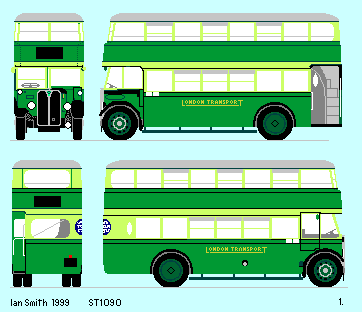 These were 48 seat, inside stair, dual gangway lowbridge bodies
by Short Bros (1089) and Strachans (1090)
for Amersham & District (which was 50% LGOC owned).
They were very similar to contemporary Watford lowbridge STs,
but with offside fuel tanks.
These were 48 seat, inside stair, dual gangway lowbridge bodies
by Short Bros (1089) and Strachans (1090)
for Amersham & District (which was 50% LGOC owned).
They were very similar to contemporary Watford lowbridge STs,
but with offside fuel tanks.They were used mainly on route 336 between Amersham and Watford except for a period during the war when replaced temporarily by Godstone STLS. At that time they had a spell at Merton on the 127, a route uprated from single-deckers due to heavy wartime loadings. During overhauls their original identity was gradually submerged, as Chiswick worked towards standardising the lowbridge ST fleet. After the war, as rare lowbridge buses they survived the purge of STs, and were converted to diesel in 1950. They lasted until 1952, when they were replaced by RLHs. ST 1091-1132 The Country STs. 2/1ST9 (Total 42)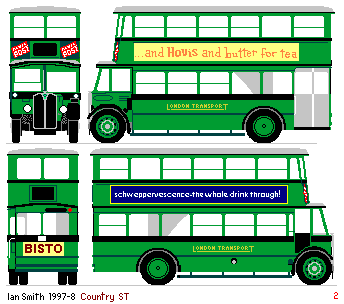 These were based on the ST1 design.
Their bodies were built by Ransomes, Sims and Jefferies of Ipswich, in 1930.
As the General's ST1s were rebuilt to the ST2 specification, and these remained unchanged,
in time they were distinguishable by their square-cornered cabs; offside fuel tanks;
double panelled rear platform windows; smaller door cut-out at rear;
different destination blind arrangements at front and rear.
All went to East Surrey. (ESTC).
30 initially belonged to LGOC but were used for ESTC services,
and another 6 were transferred to LGOC in August 1930.
These were based on the ST1 design.
Their bodies were built by Ransomes, Sims and Jefferies of Ipswich, in 1930.
As the General's ST1s were rebuilt to the ST2 specification, and these remained unchanged,
in time they were distinguishable by their square-cornered cabs; offside fuel tanks;
double panelled rear platform windows; smaller door cut-out at rear;
different destination blind arrangements at front and rear.
All went to East Surrey. (ESTC).
30 initially belonged to LGOC but were used for ESTC services,
and another 6 were transferred to LGOC in August 1930.
Livery was originally General red and white with black trim. Although this had not been East Surrey's original colour, the increased links with the General and their ownership of some of the vehicles were factors in a change to red.
In post-war days a few were transfered to the Central Area,
some retaining green for their short sojourn, some receiving red livery for a short time.
Country ST, 1933 livery. Drawing by Ian Smith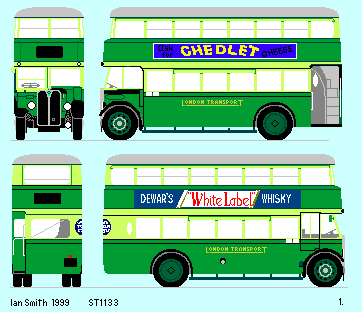
ST 1133-1138 ex Lewis STs (total 6) 2/1ST9These six buses had 48-seat six-bay inside staircase high-bridge bodies, built by Short Bros for Lewis Omnibus of Watford in 1930. They were acquired by the LPTB by takeover. They were rebodied with spare ST1 bodies in 1939/42, but not before at least one had appeared on the 410 (on the truncated wartime route between Bromley and Leaves Green).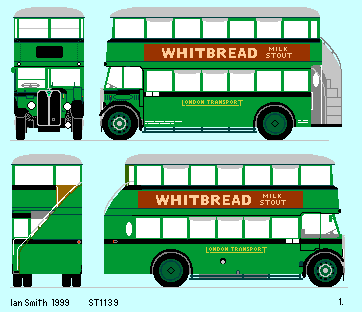
ST 1139 The first ST. (total 1)In London's odd way of making the first last and the last first, this last-numbered of the STs was actually the very first. (while ST2 was the last into service, remember?) ST 1139 had been the first AEC Regent demonstrator, with a highbridge body by Short Bros of Rochester. It had 50 seats, an open staircase, and a piano front.
As an AEC demonstrator it was registered by LGCS at Reigate in July 1929,
then appeared in Autocar livery.
It was bought by General in December 1929 and allocated to East Surrey.
During its time with LT it gained a small destination blind box at the front,
which never seemed large enough for a route number as well as a destination.
The route number was often carried on a slip-board in front of the nearside front saloon window.
ST1139 spent periods in operation at various parts of the London Country Area,
including Dunton Green, Windsor and Grays, before being withdrawn in 1948
when the RTs arrived.
|
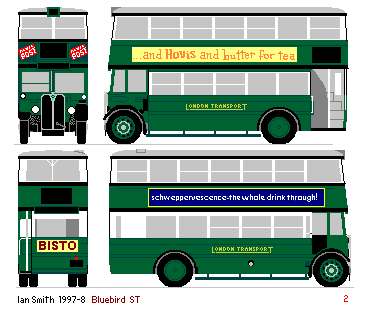
 ST1139 history
ST1139 history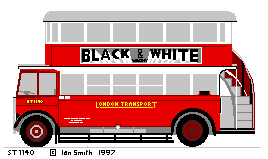
 Bus Stop
Bus Stop ST index.
ST index. Tilling STs.
Tilling STs. Country STs.
Country STs.